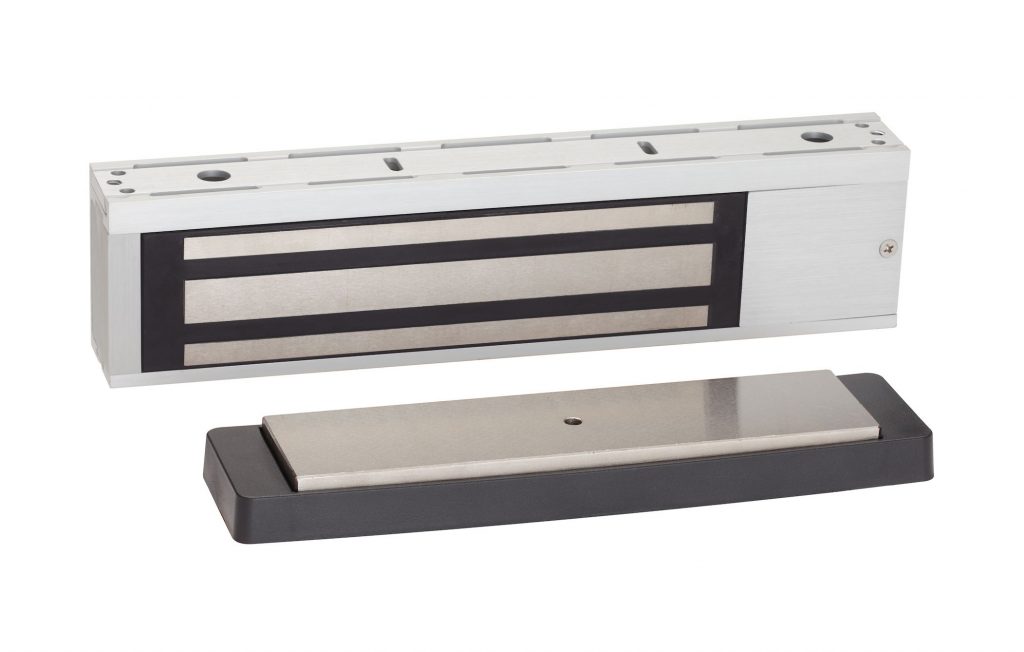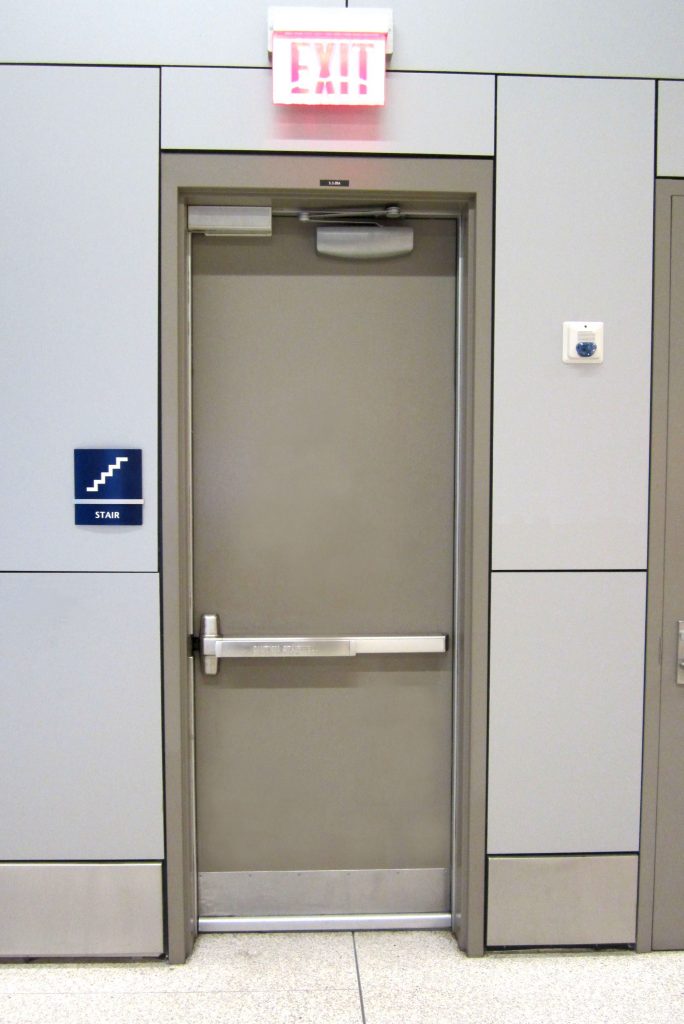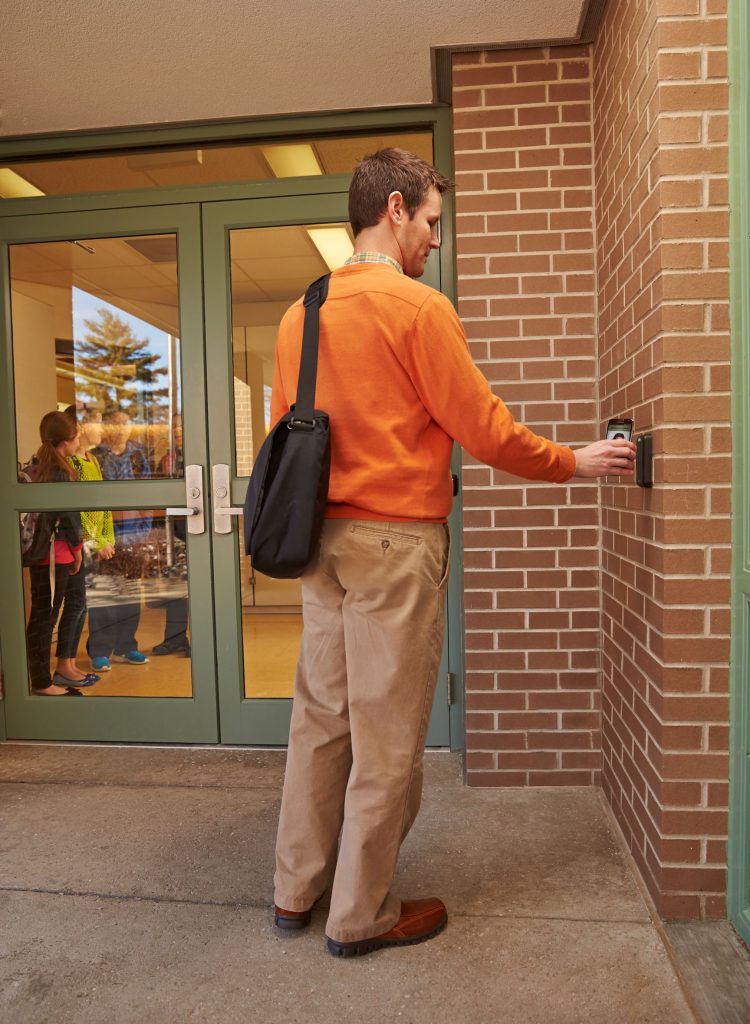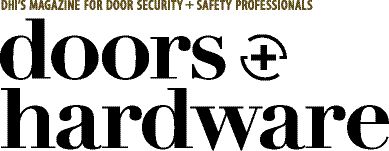This post was published in Doors & Hardware

An electromagnetic lock is essentially an electromagnet in a housing that is mounted on the door frame, with a steel armature mounted on the door. When the magnet is energized, it bonds to the armature and locks the door. To allow access or egress, a switch must be provided to de-energize the magnet.
This issue continues to arise on a regular basis, so I’m hoping to clarify it once and for all. The sections entitled “Access-Controlled Egress Doors” – found in past editions of both NFPA 101–Life Safety Code and the International Building Code (IBC), have led some to believe that all doors equipped with access control readers must comply with these sections of the model codes. Although the Authority Having Jurisdiction (AHJ) has the final say on matters of code-compliance, it’s not the intent of the model codes for these sections to apply to all access-control doors or to all doors with electrified hardware.
The requirements of the model codes specific to access-controlled egress doors are essentially the same, although the section titles are different. In the 2015 edition of the IBC, the section title was changed from Access Controlled Egress Doors to Sensor Release of Electromagnetically Locked Egress Doors. In the 2018 edition of NFPA 101, the section title was changed to Sensor-Release of Electrical Locking Systems. The reason for these changes was to help avoid confusion about when the sections should be applied.

The code requirements for access-controlled egress doors (now called “sensor-release”) apply to locks that are unlocked by a sensor that detects an approaching occupant. There are many doors with access control readers that are not required to comply with this section because the hardware allows free egress without the use of a sensor.
What’s an access-controlled egress door?
These two sections apply to electrically/electromagnetically locked doors, where the lock is released by a sensor detecting an approaching occupant. The most common type of lock that is used in this application is an electromagnetic lock (AKA mag-lock), but the section could also be used for other types of locks that are released by a sensor – for example, a power bolt. The key is that the section only applies to locks that are released by a sensor which detects an approaching occupant and unlocks the door. Most other types of electrified hardware – electromechanical locks, electrified panic hardware, electric strikes – are released by “normal” means, like turning a lever or pushing on the touchpad of the panic hardware. These are not access-controlled egress doors.
What about mag-locks released by other means?
Not all doors with electromagnetic locks are released by a sensor or required to comply with these sections of the model codes. Both the IBC and NFPA 101 also include separate sections that apply to electrically/electromagnetically locked doors that are released by door-mounted hardware incorporating a switch to release the electrified lock. Many locks used for access control are released without the use of a switch, but because mag-locks require a separate release device – a sensor or a switch in the door-mounted hardware – mag-lock applications are typically released by one of these two types of switches. In the 2015 edition of NFPA 101, the section for mag-locks released by a switch in the door-mounted hardware was called Electrically Controlled Egress Door Assemblies, but in the 2018 edition the section title was changed to Door Hardware Release of Electrically Locked Egress Door Assemblies. In the 2015 IBC, this section was called Electromagnetically Locked Egress Doors, but in the 2018 edition of the IBC, the section title was changed to Door Hardware Release of Electrically Locked Egress Doors.
What are the requirements for each of these applications?
To re-cap, applications with electromagnetic locks used for access control typically fall into one of these two categories (not both)*:
- Electrified/electromagnetic lock released by a sensor that detects an occupant approaching the door and unlocks the door for egress
- NFPA 101 Section: Sensor-Release of Electrical Locking Systems (prior to the 2018 edition: Access-Controlled Egress Door Assemblies)
- IBC Section: Sensor Release of Electromagnetically Locked Egress Doors (prior to the 2015 edition: Access-Controlled Egress Doors)
- In addition to unlocking when the sensor detects an approaching occupant, the door must unlock upon:
- Loss of power to the sensor
- Loss of power to the lock or locking system
- Activation of the building fire alarm or automatic sprinkler system, where provided, and the door must remain unlocked until the fire protection system has been reset
- A manual unlocking device (typically a push button) that is located 40 to 48 inches above the floor and within 5 feet of the door; ready access must be provided to the push button, and the button must be marked “Push to Exit.” Pushing the button must directly interrupt power to the lock, independent of the other electronics, and the door must remain unlocked for at least 30 seconds.

Electromagnetic locks may be released by door-mounted hardware like a lever handle, panic hardware, or other device equipped with a request-to-exit (REX or RX) switch or an electronic touch sensor.
- Electrified/electromagnetic lock released by door-mounted hardware that incorporates a switch to immediately release the lock for egress
- NFPA 101 Section: Door Hardware Release of Electrically Locked Egress Door Assemblies (prior to the 2018 edition: Electrically Controlled Egress Door Assemblies)
- IBC Section: Door Hardware Release of Electrically Locked Egress Doors (prior to the 2018 edition: Electromagnetically Locked Egress Doors)
- These sections require the following:
- The hardware mounted on the door must have an obvious method of operation and must be readily operated with one hand and under all lighting conditions.
- Operation of the hardware must directly interrupt the power to the lock, and the door must unlock immediately.
- The door must also unlock upon loss of power to the locking system.
- If panic hardware is required, operation of the panic hardware or fire exit hardware must release the lock.
- Note that this section does not require the door to unlock upon activation of the fire protection system or via an auxiliary push button beside the door.
Both of these types of electrified locks – those released by a sensor and those released by door-mounted hardware, must be allowed by the use group or occupancy classification; they are not allowed in every type of building. Refer to the applicable code for the list of occupancy types where these locks are acceptable, along with specific requirements regarding emergency lighting and the activation of manual fire alarm boxes. Some editions of the model codes also require the door locking system units to be listed in accordance with UL 294 – Standard for Access Control System Units.
What about other types of locks used for access control?
If an electrified lock in an access control system allows free egress without the use of a sensor or a switch in the door-mounted hardware, it is not required to comply with either of these model code sections. Because the electrified hardware allows free egress by turning a lever or pushing the touchpad of a panic device, it would be considered a “normal” door as long as it complies with the model code requirements for egress – one-operation to release the latch, releasing hardware mounted between 34 inches and 48 inches above the floor, and which requires no tight grasping, pinching, or twisting of the wrist and no key, tool, special knowledge, or effort to operate.

Many types of electrified hardware used for access control allow free egress without the use of a sensor or a switch in the door-mounted hardware, so they are not required to comply with the requirements for sensor release or door hardware release.
The IBC Commentary supports this interpretation, stating:
“The functions of an ingress control locking system are not addressed in the codes and are unrelated as long as egress is provided as required or permitted by this section and other applicable provisions of the code.”
State and local codes may vary from what is required by the model codes, so it’s important to check the code requirements for your project’s jurisdiction. Refer to the model codes for additional information; the IBC Commentary and NFPA 101 Handbook offer explanations to clarify the intent of the codes. The AHJ may be consulted for assistance with the requirements for a particular location.
* Note that mag-locks may also be used in delayed egress locking systems, controlled egress systems in health care facilities, and fail-safe systems for elevator lobby doors. Each of these applications has a separate set of code requirements that would apply instead of the sections discussed in this article. Electromagnetic locks may also be used on stair doors that must meet the stairwell reentry requirements. Typically, these doors would comply with either the section for sensor-release or door-hardware release on the egress side of the door (or the delayed egress or controlled egress sections if applicable), and would comply with the stairwell reentry requirements on the stair side.
You need to login or register to bookmark/favorite this content.







Well done…I’m always amazed by how many of the Security Contractors I run across that don’t seem to know this and tend to utilize Mag Locks way too much. Although I will say I have seen improvement over the last few years thanks to individuals like yourself whom helps to educate us poor souls and continue to hit upon these different issues.
Thanks Gary! Feel free to send a link to any security contractors who need the info. 🙂
– Lori
I don’t think the problem is the magnetic lock itself. I go back a long way with these devices (right to the inventor). Over the years, I can say unequivocally that its the design of the locking system; not the lock itself. I have mag locks installed on residence halls that have been functioning reliably since 1983; but I designed the entire door system (door, frame, reinforcements, circuit, etc) around the lock and I would guarantee that does not normally happen. As a result, mag locks get a bad rap and in some locals are simply not permitted. Now, I personally do not use mag locks much (particularly for perimeter doors), but I would submit that when designed properly, they are safe, reliable and will provide years of service. This assumes that the end user can accept the intrinsic operational issues that come with the devices; i.e. fail safe, fire alarm release and the 30 second release button next to the door.
Lori, you have a gift for making technical writing look easy. I know it is not….
Hopefully the new names for different sections will make it easier to explain to our customers.
Just one thing to check out (purely grammatical): on the very last line of your article, did you accidentally omit “with” between “comply” and “the”? As in, “and would comply with the stairwell reentry requirements on the stair side.”
Thank you for sharing your gift of technical writing with us.
Hey Lori
What an excellent article . I will be passing this on to many of my associates. It really does simplify the understanding of the operation.
Thanks again.
Hi Lori. I was reading about some states specifying red vs. green, one place allow orange.
Someday, when you have nothing else to do, would you address the green vs. red EXIT signs and vs. the green running man sign.
Also, international understanding of red means stop or danger and green means safety.
(I’ve got to find something better for my summer reading list)
I’ll see what I can find!
– Lori
oops, didn’t mean to imply that you’re off my summer reading list. I meant extracurricular reading.
Oh thank goodness! I thought you were ditching me for the summer! 🙂
– Lori
Thank you for helping to decipher the complexities of the language in the code. I am looking for information on the following scenario, though, and I don’t see that it is possible. A long corridor used for egress has public / tenant spaces and private / building spaces on either side of it. The private building spaces are all at the end of the corridor, just before the exit door. The owner wants to put double doors in the corridor, just before the private building spaces start, to keep the general public out of the “back of the house” areas, and put access control on the doors. The double doors swing towards the exit, which is towards the private building areas. The access control would fail safe and allow egress in the event of a fire or power loss. From everything I’ve read, the code will require a RQE device or button or sensor that allows free exit through the doors (egress doors), no matter what — thereby rendering the access control pointless. The best we can hope for is the AHJ allowing a delayed egress lock and hoping the public gets the hint. Is this the case or am I missing something?
Thanks, in advance, for any insight.
Hi Jay –
From the layout you’re describing it sounds like your only options would be delayed egress locks (if allowed in the occupancy type) or exit alarms. The two code sections for mag-locks will allow free egress from the public space toward the exit, so they won’t help. Doors in a means of egress can’t have locks which only unlock to allow egress when the fire alarm is actuated – the exception would be controlled egress locks in a health care unit where the patients require containment for their safety.
– Lori
Sigh. Thanks for the second set of eyes. I wish the code would address security needs instead of just egress needs for the lost and panicking.
Enjoy your day.
– Jay
Great article Lori! I have a question for you – would a touchless actuator (such as a BEA MS08) suffice in lieu of the green push to exit button for the manual unlocking device for an access controlled egress door? We often see these installed in Hospitals due to hygiene concerns.
I just listened to an NFPA webinar indicating the forthcoming 101 code will similarly change the name of the section “Access-Controlled Egress Doors” due to this same confusion. They are also including safety issues due to “unwanted intruder” scenarios and have fast tracked NFPA 3000 to deal with such emergencies, but some will make their way into 101. Thanks for the article.
Hope all is well with you. Sorry if this has already been asked.
NFPA 101 Section 7.2.1.6.2 In any occupancy where access control is permitted, does the entire building, or the floor or area where the access control is being utilized have to be sprinklerd, meaning can they install an access control in a non sprinkler building.
Thank you for your help.
Hi Ron –
This section references the sprinkler system “if provided”, so it does not mandate that the building be equipped with a sprinkler system in order to use this type of access control system. Keep in mind that this section addresses electrified locks released by a sensor (typically mag-locks) – it is not applicable to all types of access control systems. Here’s the paragraph from NFPA 101:
Activation of the building automatic sprinkler or fire detection system, if provided, shall automatically electrically unlock the door leaves in the direction of egress,
and the door leaves shall remain electrically unlocked until the fire-protective signaling system has been manually reset.
I checked the occupancy chapters, and only the chapters for new and existing mercantile occupancies require a fire protection system in order to use a sensor-release system, and it can be a fire detection system OR an automatic sprinkler system. The other chapters that allow these systems do not require the fire protection system as a condition for use of the access control system. Here’s the paragraph from the mercantile chapters:
Sensor-release of electrical locking systems complying with 7.2.1.6.2 shall be permitted in buildings protected throughout by an approved, supervised fire detection system in accordance with Section 9.6 or an approved automatic sprinkler system in accordance with 9.7.1.1(1).
– Lori
Hi Lori. I’m wondering what you think of the code compliance of having a dedicated battery backup for a IBC 1010.1.9.9 (sensor and push button) door. Keeping the power on during a loss of power will allow the tenant to maintain security.
Also, for a fire alarm or sprinkler flow, what is the intent for unlocking in a high-rise building?
– All door locks in the building release regardless of where the alarm occurs?
– Doors release on fire floor, floor above, and floor below, following the voice alarm protocol?
– Doors on the fire floor only release?
If these questions have been answered elsewhere on the site, please point me in the right direction. Thank you
Hi Tod –
Those are all great questions and I never like to say “it’s up to the AHJ” (you! LOL). But the model codes are not very specific about what loss of power means with regard to electrified locks, and I have not seen prescriptive requirements for releasing some locks upon fire alarm activation, but not all.
Because I default to the more conservative approach, I like to see the mag-locks and the fire alarm system on the same back-up power source, rather than having separate batteries in the lock power supply. This is based on what I think the intent of NFPA 72 is – there is more info in this article: https://idighardware.com/2020/06/qq-battery-back-up/.
Regarding which locks unlock upon fire alarm, I would unlock them all unless there is a really good reason. I say this only because without clear instructions in the codes I go with what will keep me out of trouble with the AHJ.
I’d love to hear your take on it!
– Lori